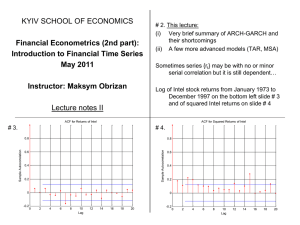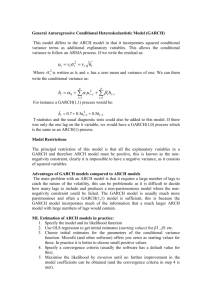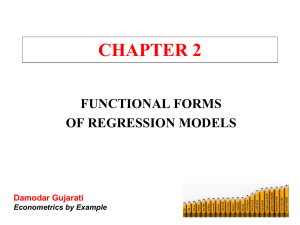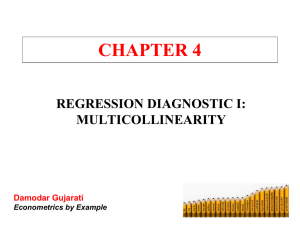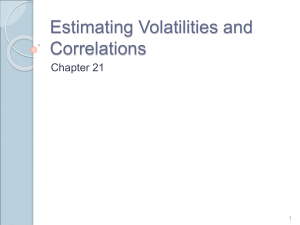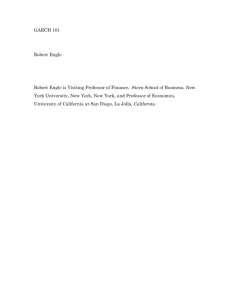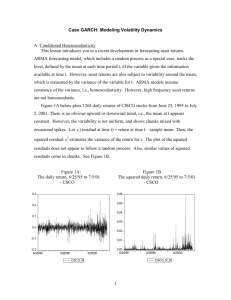Chapter 15
advertisement
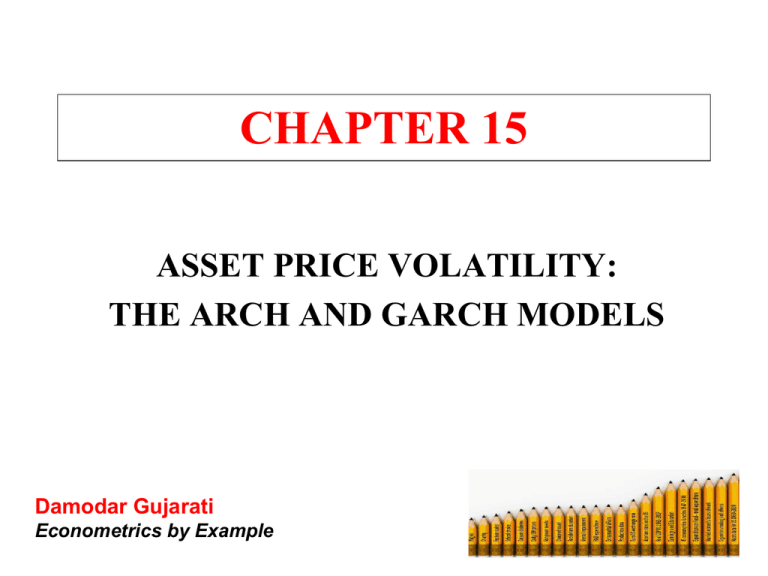
CHAPTER 15 ASSET PRICE VOLATILITY: THE ARCH AND GARCH MODELS Damodar Gujarati Econometrics by Example VOLATILITY CLUSTERING Volatility Clustering: Periods of turbulence in which prices show wide swings and periods of tranquility in which there is relative calm. Financial time series often exhibit the phenomenon of volatility clustering. This results in correlation in error variance over time. Use autoregressive conditional heteroscedasticity (ARCH) models to take into account such correlation or time-varying volatility. Damodar Gujarati Econometrics by Example THE ARCH MODEL This model shows that conditional on the information available up to time (t-1), the value of the random variable Y is a function of the variable X: Yt I t 1 X t ut We assume that given the information available up to time (t – 1), the error term is independently and identically normally distributed with mean value of 0 and variance of σt2 (heteroscedastic variance): ut It 1 iid N (0, t2 ) Assume that the error variance at time t is equal to some constant plus a constant multiplied by the squared error term in the previous time period: t2 = 0 1ut 1 , where 0 ≤ λ1 < 1 Damodar Gujarati Econometrics by Example 2 THE ARCH MODEL (CONT.) The ARCH(1) model includes only one lagged squared value of the error term. An ARCH(p) model has p lagged squared error terms, as follows: 0 1 u 2 t 2 t 1 2 u 2 2 t 2 ... p ut p If there is an ARCH effect, it can be tested by the statistical significance of the estimated coefficients. If they are significantly different from zero, we can conclude that there is an ARCH effect. Damodar Gujarati Econometrics by Example ESTIMATION OF THE ARCH MODEL The Least-squares Approach Once we obtain the squared error term from the chosen model, we can estimate the ARCH model by the usual least squares method. The Akaike or Schwarz information criterion can determine the number of lagged terms to include. Choose the model that gives the lowest value on the basis of these criteria The Maximum-likelihood Approach An advantage of the ML method is that we can estimate the mean and variance functions simultaneously. The mathematical details of the ML method are somewhat involved, but statistical packages, such as STATA and EVIEWS, have built-in routines to estimate the ARCH models. Damodar Gujarati Econometrics by Example DRAWBACKS OF THE ARCH MODEL 1. The ARCH model requires estimation of the coefficients of p autoregressive terms, which can consume several degrees of freedom. 2. It is often difficult to interpret all the coefficients, especially if some of them are negative. 3. The OLS estimating procedure does not lend itself to estimate the mean and variance functions simultaneously. Therefore, the literature suggests that an ARCH model higher than ARCH (3) is better estimated by the Generalized Autoregressive Conditional Heteroscedasticity (GARCH) model. Damodar Gujarati Econometrics by Example THE GARCH MODEL In its simplest form, the variance equation in the GARCH model is modified as follows: 0 u 2 2 t 2 1 t 1 2 t 1 This is known as the GARCH (1,1) model. The ARCH (p) model is equivalent to GARCH (1,1) as p increases. Note that in the ARCH (p) we have to estimate (p+1) coefficients, whereas in the GARCH (1,1) model given in we have to estimate only three coefficients. The GARCH (1,1) model can be generalized to the GARCH (p, q) model with p lagged squared error terms and q lagged conditional variance terms, but in practice GARCH (1,1) has proved useful to model returns on financial assets. Damodar Gujarati Econometrics by Example FURTHER EXTENSIONS OF THE ARCH MODEL GARCH-M Model Explicitly introduce a risk factor, the conditional variance, in the original regression: Yt X t ut 2 t This is called the GARCH-M (1,1) model. Further Extensions of ARCH and GARCH Models AARCH, SAARCH, TARCH, NARCH, NARCHK, EARCH, are all variants of the ARCH and GARCH models. Damodar Gujarati Econometrics by Example
